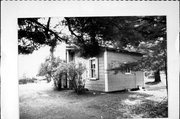Property Record
E 3961 KRON-DAHLIN
Architecture and History Inventory
| Historic Name: | |
|---|---|
| Other Name: | |
| Contributing: | |
| Reference Number: | 27572 |
| Location (Address): | E 3961 KRON-DAHLIN |
|---|---|
| County: | Ashland |
| City: | |
| Township/Village: | La Pointe |
| Unincorporated Community: | |
| Town: | 51 |
| Range: | 2 |
| Direction: | W |
| Section: | 34 |
| Quarter Section: | |
| Quarter/Quarter Section: |
| Year Built: | |
|---|---|
| Additions: | |
| Survey Date: | 1993 |
| Historic Use: | house |
| Architectural Style: | Side Gabled |
| Structural System: | Log |
| Wall Material: | Log |
| Architect: | |
| Other Buildings On Site: | |
| Demolished?: | No |
| Demolished Date: |
| National/State Register Listing Name: | Not listed |
|---|---|
| National Register Listing Date: | |
| State Register Listing Date: |
| Additional Information: | Historical Background Gust Dahlin immigrated to the United States in 1896 at the age of twenty-one. His father, Olaf, had immigrated in the earlier part of the same decade, eventually settling on Madeline Island. Olaf was a carpenter in Sweden, and constructed houses and furniture. Presumably Gust was similarly trained, and when he too settled on Madeline Island he constructed the buildings at this farmstead. Gust also built other buildings on the Island, including one section of the Madeline Island Museum [226 Colonel Woods Avenue, 43-5], and a rental property at 730 Main Street [42-16]. The buildings and land of this farmstead were used to provide the family with food essentials, not to produce items for sale. The property was purchased in 1937 by Ted Benjamin. He covered the log main house with asphalt shingle siding. Ted's brother George bought the farm in the 1960s. It is now owned by George Benjamin's step son David Heath. Historical Significance It is an outstanding, intact example of a subsistence farm built by Swedish immigrants. Of the ten farmsteads surveyed on Madeline Island in 1992-93, this is the best and earliest. The other farmstead with excellent integrity dates from 1929 and consists of wood frame, not log, buildings. Description The Gust Dahlin farmstead consists of a side gable log main house now covered in asphalt siding [47-28]; a large side gable log barn [47-26]; woodshet [47-24]; a smithy [47-25]; garage [47-23]; and a playhouse [47-27]. All the buildings except the smithy and the playhouse are constructed of unhewn logs with dovetail notching. The smithy and the play house have walls of finished logs. The construction of the main house is unknown. Architectural Significance It is an outstanding, intact example of a subsistence farm built by Swedish immigrants. Of the ten farmsteads surveyed on Madeline Island in1992-93, this is the best and earliest. The other farmstead with excellent integrity dates from 1929 and consists of wood frame, not log, buildings. The other farmsteads with log buildings are of later construction and have lost buildings. |
|---|---|
| Bibliographic References: | [A] Benjamin, George and Marjorie, Family File, MIHPA files. [B] Lorraine Motisi, interview with Rebecca Sample Bernstein, 20 June 1933, Madeline Island. [C] Myre, Mrs. Carl, Historical Madeline Island, typed manuscript, 1952, MIHPA files. |
| Wisconsin Architecture and History Inventory, State Historic Preservation Office, Wisconsin Historical Society, Madison, Wisconsin |

